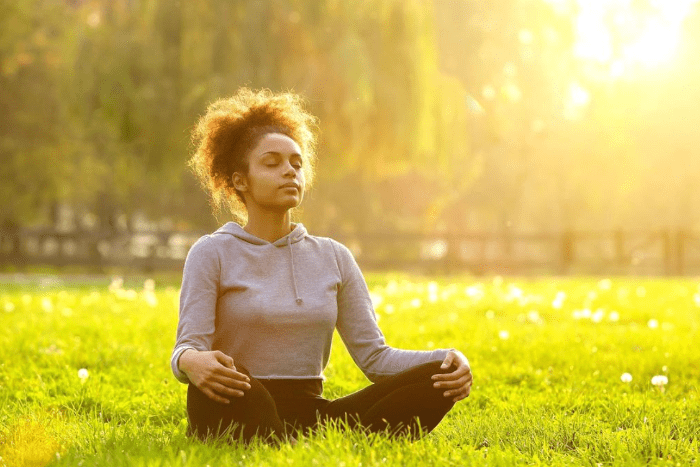
Have you felt more anxious, stressed or depressed due to the pandemic? The answer is a resounding yes for most of us. Crisis fatigue—a mixture of exhaustion, rage, despair and grief—is becoming a public health concern. Mental health problems have been an issue for 33% of all respondents in a recent survey from The Commonwealth Fund and 51% of all respondents in a new International Committee of the Red Cross study, which concluded the pandemic is causing a global mental health crisis.
Fortunately, there are plenty of great strategies to help alleviate anxiety, stress and depression in our everyday life. But one in particular—breathing—is easy, immediate, effective and economical.
Most of us misunderstand breathing and see it as a passive activity. But breathing the right way is not that simple. How you breathe matters; it lets you maximize this seemingly unconscious act to reap its many benefits—which makes it imperative to learn how to breathe the right way.
Learning to Breathe Right Can Change Your Life
How you breathe has profound effects on your health. James Nestor pointed this out in The Wall Street Journal when his now best-seller, Breath: The New Science of a Lost Art, was published earlier this year. His research on the respiratory process confirms that the quality of your breathing has dramatic physical effects on both your body and mind.
Breathing properly—through slow, rhythmic respiration—can increase your relaxation response, decrease blood-sugar levels, lower your heart rate, reduce muscle tension and pain, increase strength and circulation, improve digestion, promote relaxation, help you focus and regenerate your immune system, as I pointed out in my book, “Emotional Yoga: How the Body Can Heal the Mind.”
By contrast, not breathing properly can cause or worsen a laundry list of chronic conditions and diseases, from anxiety and depression to asthma, high blood pressure, hypertension and more, Nestor noted.
No wonder learning to breathe can make life better, a point driven home in Scientific American. The many benefits it yields for your body and mind can lead to a longer and healthier life.
Breathing for Better Health
But why does something as simple as breathing have such a huge impact on your health? Harvard Medical School explains it best:
Shallow breathing, which we often do when we breathe through our mouths, doesn’t allow a full share of oxygenated air to reach the lowest part of our lungs. Because of this, we can feel short of breath and anxious.
Deep breathing—encourages full oxygen exchange. When you breathe deeply, the air coming in through your nose fully fills your lungs, and the lower belly rises slightly. This is the beneficial trade of incoming oxygen for outgoing carbon dioxide. Not surprisingly, it can slow the heartbeat and lower or stabilize blood pressure.
As you regulate the flow of your breath in your body, you affect the quality of your mind. When breathing slows down, your thinking process slows and you attain steadiness. When your mind becomes still, breathing is calm. When your breathing almost stops, your mind comes to a standstill and you enter a state of “restful alertness.” This is the beginning of meditation.
A centuries-old yogic technique, pranayama, built a theory around deep breathing. The practice is a form of deliberately regulating your breathing cycle, and holds that controlled breathing is a way to increase longevity, Scientific American explains.
Given what’s at stake—significantly better health—it’s time to realize that breathing properly is as much a science as an art. But you don’t need to be taught how to breathe to survive. You already know how to do that. Now it’s time to learn how to breathe properly to bring health, happiness and healing for your body and mind.
Some simple and proven techniques and practices can help. Top on the list is conscious breathing.
Conscious Breathing Benefits
Conscious breathing, or directing your attention to the process of breathing, is a powerful tool to optimize health, increase longevity, dissolve fear, manage your emotions and develop higher states of consciousness. It’s simply the easiest and most powerful stress reduction tool you can use to support, manage, and sustain your health regardless of your age or condition.
When you observe your breathing, you become alert to what’s happening in your body and mind. Once you’re familiar with your breath’s many variations and how they affect you, it’s possible to use that knowledge to help you moderate how you feel at any time and in any situation.
A Quick Primer on Conscious Breathing Techniques
What makes the practices of pranayama unique is that your attention is on your breath rather than your body. To do this, you deliberately control your breathing cycle by regulating one or more of your breath’s four parts:
- Exhalation
- Hold your breath out with empty lungs
- Inhalation
- Hold your breath in with full lungs
The pause marks the point where the breath ends and comes naturally after each inhalation and exhalation. It is called kumbhaka, or pot, in Sanskrit. All yogic breathing practices are created by modifying one or more of these four phases of the breath and combining them in relation to one another.
It’s that simple—yet not always so easy. The point is to learn how to breathe properly and intelligently, and be conscious of how and why you are breathing.
Here are two simple practices that teach you how to breathe to achieve better health.
Practice 1: Breathing Awareness
In these breathing exercises, your attention should follow the natural flow of the breath—downward with the breath on inhale, and upward with the breath on exhale. Keep your mouth closed and breathe with a smooth and subtle sound passing from your throat to your nostrils.
If you wish to promote more alertness, it’s best to sit as you practice. Lying down tends to relax or even put you to sleep. Find the best posture by asking your body what it wants to do.
The following practice settles and soothes agitated emotional states, such as anger, anxiety, frustration and fear. It relaxes the body, calms the mind and creates a state of “restful alertness.”
- Sit in a comfortable position and focus on your breathing patterns. Observe the flow of your breath, how it comes and goes. Ride your breath like a wave. Inhale and pause. Then exhale and pause. Inhale all the way to the end of your breath and feel the completion of your breath, waiting for your next breath to begin. Exhale all the way to the end and feel the completion of your breath, waiting for your next breath to begin. Lengthen your breath naturally, following it with your awareness.
- Your breath comes in and stops. Your breath goes out and stops. It’s effortless. You’re pouring the inward into the outward breath, and the outward into the inward breath. Then, your breath ceases flowing in the silent space between each breath.
- Listen to the silence inside as you pause between each breath. Be aware of the silence—and stay in the silence.
- Continue breathing for at least 8 to 10 breaths. Allow your breath to come back to its normal state. Notice how you feel.
Practice 2: Stress Reduction Breathing Exercise
(Note: you can continue into this practice from the previous one.)
This practice is especially helpful during uncertain times, no matter what the external circumstances may be. It uses a Langhana (from Sanskrit, meaning “to reduce” or “to eliminate” anything in excess) strategy of breath regulation, and is effective for calming the nervous system and promoting self-awareness. You can use it to manage stress, promote deep relaxation and find inner stillness and peace.
- Begin to tune in to your body and focus your attention on your breath. Inhale all the way to the end of your breath and feel the completion of the breath. Exhale all the way to the end of your breath and pause.
- Slowly begin to place an emphasis on your exhalation. Gradually increase the length of your exhale as you breathe. You may begin to follow the ratio below to gradually increase the length of your exhalation and hold. Continue to use it as your guide and modify it in any way you need to. Never force your breath. Advance slowly.
- If you have time, lie down and rest at the end of your breathing practice. Make a gradual transition into your next activity.
Breathing is one of the greatest secrets of yoga
If you practice it with sincerity, you will obtain mental and emotional healing powers beyond your imagination. Yet, breathing itself is not a secret. It’s right there. If you train yourself in one area only, be awake to your breath. It’s that basic. You can build your whole life around it.
(Originally published for AGEIST Magazine)

Get cutting-edge info on the latest wellness trends.
Sign up for Bija’s monthly newsletter.

Master the vitality of your body and mind. Strive to seek clarity. Generate energy. Restore, Reboot.
Contact Bija for the rigor and science to support your journey.
